
Molly Blumhoefer thinks managing energy is just one piece of the puzzle in ensuring Sandia operates efficiently and sustainably. She’s part of Sandia’s energy management team, which has been busy creating a system to organize, measure, improve and, when needed, troubleshoot energy use across the Labs’ California and Albuquerque campuses.
The DOE recently acknowledged the team’s efforts by recognizing Sandia as a 50001 Ready site. This designation shows that Sandia is a leader in energy management and performance improvement.
“Going through this process to become recognized by the DOE as 50001 Ready underscores the importance of energy management at Sandia and makes it sustainable long-term,” Molly said. “Meeting their requirements emphasizes and supports what we are doing and gives us credibility moving forward as we continue to make our operations more energy efficient.”
The team, which also included Danny Alkon, Michael Flores, João Oliveira and Nicole Rinaldi, partnered with Global Strategic Energy to complete the 25 tasks required to achieve 50001 Ready designation, which mimics the structure of the international standard for energy management, ISO 50001. A recent order by DOE recommends that all agency facilities consider implementation of an ISO 50001 or 50001 Ready program to track, analyze and improve energy efficiency.
Setting a baseline
Sandia is no stranger when it comes to tracking energy use, so the team started by assessing what existing tools could meet program requirements. “We already had an energy management system in place,” Molly said, “so we just needed to document our efforts and make the system more robust.”
That need to enhance current practices also extended to the way Sandia models energy use. Rather than just dividing energy use by area, the team added the capability to normalize consumption based on weather.
“Now, if we see a big spike in energy use across the site, we can assess whether it’s due to weather or indicates a bigger problem — like a system malfunctioning. Not having to spend as much time investigating a trend will have a huge impact on how we move forward,” Molly said.
Another important baseline required designating a few buildings or systems as significant energy users based on their high energy consumption and opportunities for improvement. The team chose two buildings in Albuquerque and one in California. By identifying these users, the team could focus their efforts and increase their impact, said Casiano Armenta, acting manager of Sandia’s energy and infrastructure data management group.
“For example, we chose the high-performance computing building because it uses a lot of power. But also, we can’t just shut off the computers, right?” Casiano said. “So, we need to keep the systems up and running to meet the team’s needs but be as efficient as possible.”
Each building or system has a crew devoted to keeping an eye out for problems and implementing energy conservation measures. These buildings can then serve as templates for replicating improvements across the broader campuses.
After completing the 50001 Ready program tasks, the team underwent both an internal audit and an audit performed by the contractor to identify any weaknesses. The audits found only one nonconformity, which the team fixed immediately, and a few other areas of concern. Molly said they are brainstorming creative ways to overcome these challenges, such as how to align the ISO 50001 standards with other federal sustainability directives Sandia must achieve.
Energy leadership

In addition to saving energy to reduce costs, energy management supports Sandia’s commitment to model the way forward in site sustainability both among the national laboratories and in the community. “We want to be as cutting-edge as possible and be a leader in this dynamic environment,” Casiano said.
Sandia is committed to achieving net-zero emissions by or before the U.S. goal of 2050. While most people associate net zero with increasing alternative energy, Casiano thinks about energy conservation. “The starting point is needing to be as efficient as we possibly can with the energy that we’re using now.”
Molly views this work as one of the ways Sandia can act as a responsible neighbor, especially since our Albuquerque campus is in close proximity to underserved communities. “We need to be a good steward of the land and taxpayer dollars. We need to do our part because our efforts can have a huge impact on the environment.”
One additional outcome of going through the 50001 Ready process was meeting with people from across the Labs to discuss future risks and opportunities related to energy management. Climate change, utility rates and an expanding mission all came up in conversations that wouldn’t have happened otherwise, Molly said.
“We need to be able to anticipate how climate change might impact our heating and cooling systems. For example, increasing wildfires could drive stricter guidelines for indoor air quality, which would drive up energy demands,” Molly said.
Continuing the journey
Now that Sandia has achieved the 50001 Ready recognition from DOE, the team is starting to think about full ISO 50001 certification. “I feel at this point, we could go into another third-party audit and feel confident about our program,” Molly said.
In the meantime, the team continues to find ways to improve energy management and lower consumption. Other initiatives, such as Smart Labs and Monitoring-based Commissioning, help ensure buildings perform as expected, leading to greater occupant safety and comfort.
It’s not just the energy management professionals who can contribute to these efforts, Casiano said. A feature recently added to the Sandia Maps employee portal allows users to see how much energy a building consumes. That awareness can extend to each time one enters a building.
“Just like you would in your own home — if you have a leaky faucet, if you notice something wasteful, put in a ticket,” Casiano said. “We want Sandia staff to be the eyes and ears of what is going on in our buildings. If you have an idea, let us know — because all those little things add up.